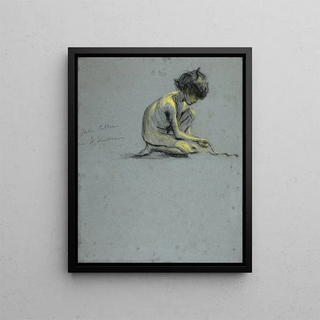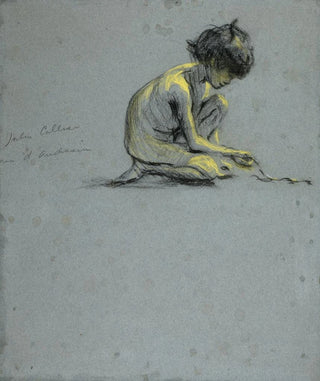Painting Boy crouching with a snake - Alice Pike Barney | Art print


View from behind

Frame (optional)
The artwork "Crouching Boy with a Serpent" by Alice Pike Barney is an invitation to immerse oneself in a universe where childhood, nature, and mystery converge. This depiction of a young boy interacting with a serpent evokes themes of curiosity, danger, and innocence. The composition, both simple and poignant, captures the eye and prompts reflection on the relationship between humans and animals, as well as on the fragility of childhood in the face of a wild world. Gazing at this piece, the viewer is transported to a suspended moment, where time seems to stand still, allowing for a full immersion in the emotion conveyed by this scene.
Style and uniqueness of the work
Alice Pike Barney, through this painting, demonstrates undeniable talent in capturing the essence of her subjects. Her style, characterized by a subtle use of color and light, imparts an almost ethereal atmosphere to the piece. Warm, earthy tones, combined with touches of light, create a contrast that highlights the texture of the boy's skin and the serpent's scales. This attention to detail, coupled with a balanced composition, allows one to feel a palpable tension between the protagonist and his environment. The work also stands out for its ability to evoke visual storytelling, where each element, from the boy's gaze to the serpent's posture, tells a unique story.
The artist and her influence
Alice Pike Barney is an iconic figure of the early 20th century, whose work has often been overshadowed by her male contemporaries. Born in 1857, she managed to establish herself in the art world thanks to her innovative approach and her unique sensitivity. Influenced by Impressionist and Symbolist movements, she developed a style that is her own, blending realism with dreamlike elements. Barney was also a passionate advocate for women's rights in the artistic field, paving the way for many artists who followed her. Her work, although sometimes underrated, continues to inspire and fascinate, testament to her lasting impact on art history.
A wall decoration

Matte finish

View from behind

Frame (optional)
The artwork "Crouching Boy with a Serpent" by Alice Pike Barney is an invitation to immerse oneself in a universe where childhood, nature, and mystery converge. This depiction of a young boy interacting with a serpent evokes themes of curiosity, danger, and innocence. The composition, both simple and poignant, captures the eye and prompts reflection on the relationship between humans and animals, as well as on the fragility of childhood in the face of a wild world. Gazing at this piece, the viewer is transported to a suspended moment, where time seems to stand still, allowing for a full immersion in the emotion conveyed by this scene.
Style and uniqueness of the work
Alice Pike Barney, through this painting, demonstrates undeniable talent in capturing the essence of her subjects. Her style, characterized by a subtle use of color and light, imparts an almost ethereal atmosphere to the piece. Warm, earthy tones, combined with touches of light, create a contrast that highlights the texture of the boy's skin and the serpent's scales. This attention to detail, coupled with a balanced composition, allows one to feel a palpable tension between the protagonist and his environment. The work also stands out for its ability to evoke visual storytelling, where each element, from the boy's gaze to the serpent's posture, tells a unique story.
The artist and her influence
Alice Pike Barney is an iconic figure of the early 20th century, whose work has often been overshadowed by her male contemporaries. Born in 1857, she managed to establish herself in the art world thanks to her innovative approach and her unique sensitivity. Influenced by Impressionist and Symbolist movements, she developed a style that is her own, blending realism with dreamlike elements. Barney was also a passionate advocate for women's rights in the artistic field, paving the way for many artists who followed her. Her work, although sometimes underrated, continues to inspire and fascinate, testament to her lasting impact on art history.
A wall decoration
12,34 €






